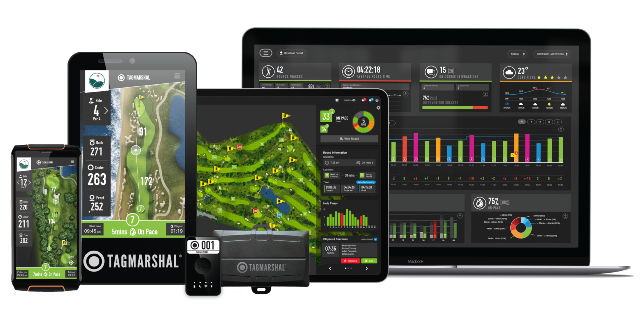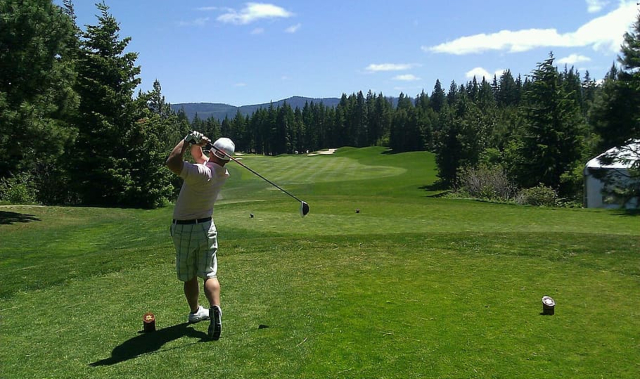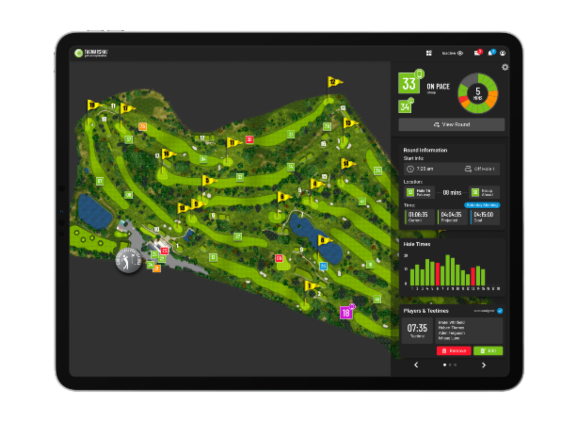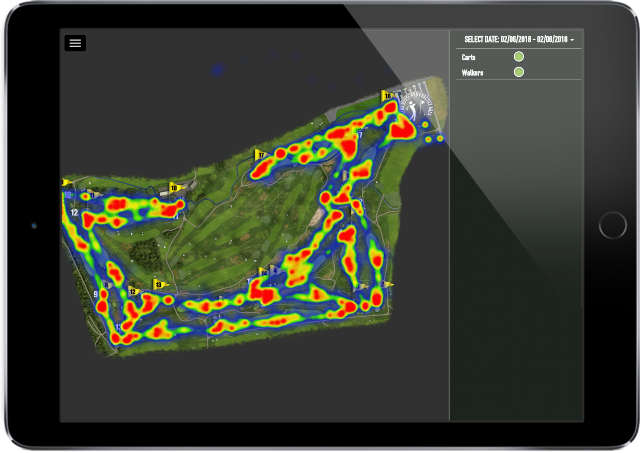Golf Cart GPS: Driving Revenue Gains Through On-Course Optimization
GOLF CART GPS: DRIVING REVENUE GAINS THROUGH ON-COURSE OPTIMIZATION
Advances in technology, such as the rise in popularity of golf cart GPS tracking, have made it easier for modern-day course owners and operators to optimize their operations.
In doing so, courses are able to enhance the player experience through effective pace of play management and improve efficiency through automation.
Courses and clubs can choose to offer discounts and other incentives in the hopes of attracting new golfers to hit their annual revenue targets, but optimization also has an important role to play here.
With golf cart GPS technology driving on-course improvement, additional revenue opportunities can be created without adversely impacting the player experience.
MANAGING TEE TIME INTERVALS USING GOLF CART GPS TRACKING
One of the most easily controllable factors affecting course capacity is the tee time interval, meaning the time left open between tee times.
Courses determine tee time intervals based on what works best with their specific setup, which can be tracked using golf cart GPS technology. Some courses may only allocate 7 or 8 minutes between tee times, whereas others opt for 12 or even 15 minutes.
The reason for these intervals is to ensure the pace of play remains steady and bottlenecks and delays don’t develop on the course, leading to player frustration and increased interactions with player assistants (or marshals).
Tagmarshal’s optimization software, and in particular the pace distribution features one can monitor throughout the day, helps course operators to identify if there is room for tightening these intervals.
“For continuous improvement, we need to have data. From a pace of play standpoint, that’s where Tagmarshal really helps us out with the ability to track and manage, based on real-time and historical data.”
Mike O’Reilly, PGA Head Professional Whistling Straits
Understanding pace distribution, as opposed to average round time, gives courses a far better understanding of the actual pace experience. Even at a course where the desired round time is 4-and-a-half hours and the average goal time is just above that, for example, there will be a large number of rounds that do not finish on pace.
Quicker rounds, such as those that tee off early in the morning, mask this in the same way that a pleasant daily average temperature doesn’t account for the cold mornings and nights and midday heat.
If the golf cart GPS data shows that a majority of playing groups are consistently finishing below the course goal time, then an opportunity may exist to tighten the tee time intervals without negatively affecting the player experience.
BUILDING ADDITIONAL TEE SHEET CAPACITY
Tightening tee time intervals means a course can build additional tee sheet capacity, offering more tee times across any given day, month or season.
Again, this is course-specific and depends on a multitude of factors. Some courses will optimize at a specific time of day, and others may see an opportunity to tighten intervals on certain days of the week, aligned with the pace of play data they’re getting from their golf cart GPS tracking system.
When implemented and managed effectively, creating additional capacity is a win-win for courses and players.
Think of it as an airplane that increases legroom for all passengers and adds extra rows of seats. The airline makes more money from the extra capacity and can charge more for their improved seats, while all the passengers have a better experience with more legroom.
“The data has allowed us to optimize tee sheet capacity and improve flow – enhancing the guest experience and increasing golf revenue by 25%.”
Chip Hierlihy, General Manager Fieldstone Golf Club
Along with charging more for in-demand tee times, the increased tee sheet capacity derived from effectively using your golf cart GPS technology means more players and increased green fee revenue, which goes straight to your bottom line.
However, the building of additional tee sheet capacity to generate additional revenue will only be successful if properly implemented.
MANAGING COURSE FLOW WITH GOLF CART GPS TRACKING
It’s essential that course owners and operators manage pace and flow to ensure that the player experience is not compromised.
Monitoring Tagmarshal’s Live Map feature means you’re always up to date with the status of play on your course and can be done via PC, tablet, or mobile phone while on the go.
The golf cart GPS tracking feature also gives courses the ability to spot pace-related issues before they negatively affect the entire field. One out-of-position group can have a serious impact on course flow, especially when intervals have been tightened, so proactive pace of play management is advisable to stay one step ahead.
Starter accuracy is also a crucial component of achieving a steady pace of play. Starting late immediately puts playing groups at a disadvantage, and that time will need to be made up later in the round if they want to stay in position.
Courses can track and measure starter accuracy using golf cart GPS data and reports should be compiled on a weekly or monthly basis. Over time, if it’s clear that starter accuracy is low, courses should identify the cause of the problem and work towards fixing these.
“With Tagmarshal, we’re able to improve the way in which we manage activity on the course, directly impacting on the golfer’s experience.”
Jeff Simonds, Assistant GM and Senior Director of Operations Bandon Dunes Golf Resort
INCREASING TEE SHEET CAPACITY FOR PRIVATE COURSES
While generating additional green fee revenue is great for daily fee and resort courses, there are a number of benefits to private courses utilizing golf cart GPS technology to add tee times, too.
Doing so means members have more opportunities to play, and a happier member base leads to greater retention. If the player experience remains unaffected by the higher volume of rounds, clubs could also consider increasing membership numbers, bringing with it a sizeable spike in revenue. The option to raise the price of an annual membership is also something clubs have looked at on the back of increased tee sheet capacity.
Quicker rounds and happier members also lead to an increase in spending post-round, both at the pro shop and on food and beverages.
“Tagmarshal has really been beneficial and our bottom line has increased tremendously.”
Lowell Weaver, Managing Partner The Medalist
WHY DAILY FEE AND RESORT COURSES ARE FOCUSING ON GOLF CART GPS OPTIMIZATION
If daily fee and resort courses are creating an experience that makes players want to return, then revenue gains should follow.
For every additional player that tees off at a resort course, for example, there is the extra spend that comes with accommodation, meals and use of amenities like the spa.
“It has enabled us to effectively implement our pace of play policy, assisting us in reducing playtime, which allowed us to add additional tee times for extra capacity.”
Jim Lombardo, Head Golf Professional Erin Hills
Along with the added revenue that comes from additional tee sheet capacity, improving a course’s pace of play also opens up the opportunity to utilize dynamic pricing.
When courses can guarantee a quick round at certain times of the day, such as early morning tee times, and this is backed up by data, players are willing to pay a premium to secure these.
BOTTOM LINE GAINS THROUGH INCREASED EFFICIENCY
Along with generating additional revenue, optimization technology also increases a course’s efficiency.
Fewer marshals (or player ambassadors) are needed to patrol the field, with the Live Map giving owners and operators full, real-time oversight of a course at any given time. Courses are able to do more, with fewer resources, saving on labor costs.
Golf cart GPS tracking also broadens how a course can use geofencing, with alerts set up to trigger as a walking group or cart enters a restricted or protected area. This helps drive down the costs associated with course upkeep, as well as increasing the efficiency with which the maintenance team operates.
Tagmarshal’s Heat Map feature shows superintendents which parts of the course suffer the most wear and tear so that fertilizer and watering can be carried out optimally.
Whereas improving course conditioning has often come at a premium, taking up a large chunk of the annual budget, optimizing on-course operations increases a course’s bottom line gains, without prohibitively increasing costs.
ABOUT TAGMARSHAL
Tagmarshal, the market leader in on-course optimization technology, provides courses with full, real-time operational oversight and reporting, giving golf operators the tools to manage pace and flow of play effectively, resulting in enhanced player experiences, increased efficiency through automation, and additional revenue generation.
Tagmarshal’s technology has collected over 1 billion data points from more than 50 million rounds of golf and has relationships with in excess of 500 partners, including Hazeltine, Whistling Straits, Baltusrol, Fieldstone, Bandon Dunes, Serenoa and Erin Hills.
Tagmarshal partners with several golf management groups, private, daily fee, public and resort courses, including 35 of the Top 100 US courses, as well as many $30-$50 green fee courses, which are seeing excellent results using the system.





 WATCH DEMO
WATCH DEMO